Multivariate Calculus for Machine Learning (Part 2)-Introduction to Functions
Before diving into calculus, we should first talk briefly about what functions are and where we use them. In this blog post, we will delve into the concept of functions in calculus. We will explore what functions are, how they are represented, and how they play a crucial role in calculus. By the end of this article, you will have a solid understanding of functions and their significance in the world of calculus.
Section 1: Introduction to Functions
Essentially, a function is a relationship between some inputs and an output.
Functions form the foundation of calculus, serving as essential tools for analyzing and understanding mathematical relationships. A function is a rule that assigns each input value (known as the independent variable) to a unique output value (known as the dependent variable). In other words, a function takes an input and produces an output based on a specific relationship.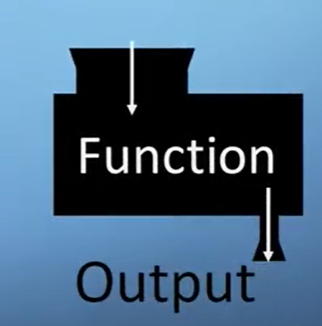
Example
So, for example, if I had a function for modeling the distribution of temperature in this room, I might input the x, y, and z coordinates of a specific location I’m interested in as well as the time, t. And then the function would return me the temperature at that specific point in space at that moment in time.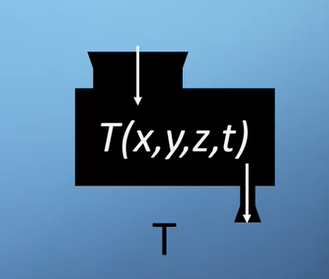
Section 2: Notation and Representation
Functions can be represented in various ways. One common representation is using algebraic notation, where a function is denoted by a letter (often “f”) followed by parentheses containing the independent variable. For example, f(x) represents a function of x. Another way to represent functions is through graphical notation, where the relationship between the input and output values is depicted on a coordinate plane.
Like so many areas of maths, even if the idea is quite straightforward, often, the notation can make things unnecessarily confusing. We’ll be confronted by this again later in the course and although it’s sometimes fairly arbitrary historical reasons that decide this, like different people inventing different parts of maths at different times, it can also be because a particular notation style is more convenient for the specific application it was developed for.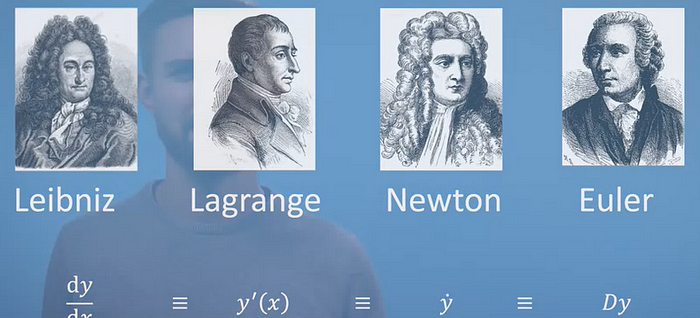 However, and here is where a lot of the problems seem to arise, in order to use and play with the interesting applications of maths, it requires you to have done quite a large amount of often quite boring groundwork. Mathematical language is like learning any other language in that respect. You can’t enjoy French poetry until you’ve learned a lot of French vocabulary and grammar including all its quirks and irregularities. Quite understandably, some people find this off-putting. My French is still terrible, for example. This is made worse by the fact that most people have not even realized that there is maths poetry waiting for them at the end of this algebra tunnel. Machine learning is a whole genre of this poetry,
However, and here is where a lot of the problems seem to arise, in order to use and play with the interesting applications of maths, it requires you to have done quite a large amount of often quite boring groundwork. Mathematical language is like learning any other language in that respect. You can’t enjoy French poetry until you’ve learned a lot of French vocabulary and grammar including all its quirks and irregularities. Quite understandably, some people find this off-putting. My French is still terrible, for example. This is made worse by the fact that most people have not even realized that there is maths poetry waiting for them at the end of this algebra tunnel. Machine learning is a whole genre of this poetry,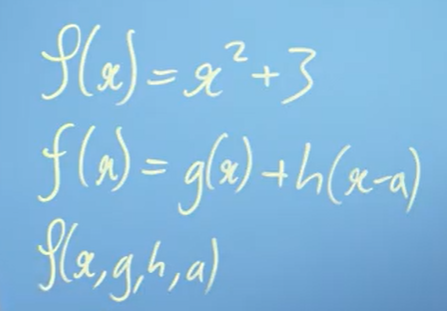 Back to functions. We often see expressions such as f of x equals x squared plus three. Perhaps, the only thing worth mentioning about this notation style is, yes, I admit it, it is absurd that you should somehow just know that “f(x)” means f is a function of x and not f multiplied by x. Sometimes, this gets genuinely unclear when other bracket terms appear in your expression. For example, f of x equals this thing over here. You can assume that g, h, and a are all not variables. Otherwise, I would have to write f of x, g, h, and a. But you could only know for sure what was going on here if it was explained to you with more context. For example, is g a function being applied to x? What about h and a over here? Maybe they’re both just constants, although you do face the same problem of missing context in any language like the famous panda who goes to a restaurant and eats shoots and leaves and they were both delicious. I can only apologize on behalf of maths and hopefully console you with two facts. Firstly, maths is at the core of my day job and I often still get confused myself. And secondly, I still love it and I get better at second-guessing any missing context all the time, just like any other language.
Back to functions. We often see expressions such as f of x equals x squared plus three. Perhaps, the only thing worth mentioning about this notation style is, yes, I admit it, it is absurd that you should somehow just know that “f(x)” means f is a function of x and not f multiplied by x. Sometimes, this gets genuinely unclear when other bracket terms appear in your expression. For example, f of x equals this thing over here. You can assume that g, h, and a are all not variables. Otherwise, I would have to write f of x, g, h, and a. But you could only know for sure what was going on here if it was explained to you with more context. For example, is g a function being applied to x? What about h and a over here? Maybe they’re both just constants, although you do face the same problem of missing context in any language like the famous panda who goes to a restaurant and eats shoots and leaves and they were both delicious. I can only apologize on behalf of maths and hopefully console you with two facts. Firstly, maths is at the core of my day job and I often still get confused myself. And secondly, I still love it and I get better at second-guessing any missing context all the time, just like any other language.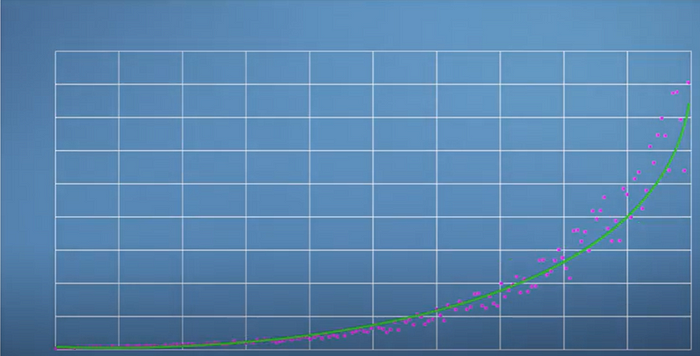 In the following exercise, I’m either going to show you some data or describe a concept to you and you’re going to have to select a function which you think might be used to represent it. This is not intended to be a difficult exercise but what I would like you to understand is that selecting a function is the creative essence of science. This process of selecting a candidate function or hypothesis to model a world is what the great geniuses of science are remembered for.There then follows a potentially long and difficult process of testing this hypothesis but there will be nothing to test without that first creative step.
In the following exercise, I’m either going to show you some data or describe a concept to you and you’re going to have to select a function which you think might be used to represent it. This is not intended to be a difficult exercise but what I would like you to understand is that selecting a function is the creative essence of science. This process of selecting a candidate function or hypothesis to model a world is what the great geniuses of science are remembered for.There then follows a potentially long and difficult process of testing this hypothesis but there will be nothing to test without that first creative step.
Section 3: Domain and Range
The domain of a function refers to the set of all possible input values for which the function is defined. It represents the horizontal axis on a graph. The range, on the other hand, refers to the set of possible output values produced by the function. It represents the vertical axis on a graph. Understanding the domain and range of a function is crucial in calculus as it helps determine the limits and behavior of the function.
Section 4: Types of Functions
There are various types of functions encountered in calculus. Some common types include linear functions, quadratic functions, exponential functions, logarithmic functions, trigonometric functions, and polynomial functions. Each type of function has its unique characteristics and properties, which are important to understand when working with calculus problems.
Section 5: Evaluating Functions
To evaluate a function at a specific value, you substitute that value into the function’s equation and perform the necessary calculations. For example, if we have the function f(x) = 2x + 3 and want to evaluate it at x = 5, we substitute x with 5 to get f(5) = 2(5) + 3 = 13. Evaluating functions allows us to determine the corresponding output values for different inputs.
Section 6: Composition of Functions
Function composition involves combining two or more functions to produce a new function. This is done by taking the output of one function and using it as the input for another function. The composition of functions is denoted by (f ∘ g)(x), where f and g are two functions. Understanding function composition is essential in calculus as it enables us to analyze complex relationships between variables.
Section 7: Differentiation of Functions
Differentiation is a fundamental concept in calculus that deals with finding the rate at which a function changes. It involves calculating the derivative of a function, which represents its rate of change at any given point. The derivative of a function provides valuable information about its slope, concavity, and critical points. Mastering differentiation is crucial for solving optimization problems and analyzing the behavior of functions.
Section 8: Integration of Functions
Integration is another essential concept in calculus that involves finding the area under a curve or the antiderivative of a function. It is essentially the reverse process of differentiation. Integration allows us to determine the total accumulation or net change of a quantity over a given interval. Understanding integration enables us to solve problems related to finding areas, volumes, and averages.
Section 9: Applications of Functions in Calculus
Functions play a vital role in various real-world applications of calculus. They are used in physics to model motion, in economics to analyze supply and demand curves, in biology to describe population growth, and in engineering to optimize designs. By understanding functions in calculus, you gain powerful tools for solving problems across different disciplines.
Section 10: Conclusion
In conclusion, understanding functions is crucial for mastering calculus. Functions provide a structured way to analyze mathematical relationships and form the basis for many calculations in calculus. By comprehending the concepts discussed in this article — from notation and representation to differentiation and integration — you will be well-equipped to tackle more advanced calculus topics and apply them to real-world scenarios.
Please Follow coursesteach to see Next Multivariate Calculus for Machine Learning story
If you want to learn more about these topics: Python, Machine Learning Data Science, Statistic For Machine learning, Linear Algebra for Machine learning Computer Vision and Research
Then Login and Enroll in Coursesteach to get fantastic content in the data field.
Stay tuned for our upcoming articles where we will explore specific topics related to Multivariate Calculus for Machine Learning in more detail!
Remember, learning is a continuous process. So keep learning and keep creating and sharing with others!💻✌️
Note:if you are a Multivariate Calculus export and have some good suggestions to improve this blog to share, you write comments and contribute.
if you need more update about Multivariate Calculus for Machine Learning and want to contribute then following and enroll in following
👉Course: Multivariate Calculus for Machine learning’
References
1-A Gentle Introduction to Matrix Calculus
2-How can calculus be used in Machine Learning?
3-mathsisfun
4-Mathematics for Machine Learning: Multivariate Calculus
5-Function











































